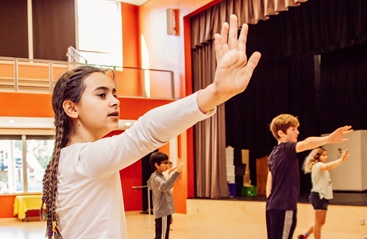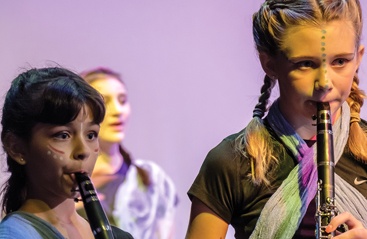Multi-Age Classrooms: Frequently Asked Questions
What are multi-age classrooms?
Multi-age classrooms, also referred to as mixed age or mixed grade classrooms, are classrooms where students work and learn together across more than one grade level. In Burgundy’s 2nd – 3rd, and 4th – 5th grade classes, students work and learn together across two grade levels: Each multi-age class is roughly half one grade and half the other and is taught by two co-teachers.
Why do we have multi-age classrooms?
We believe that children deserve a developmental approach that engages and challenges children as they are ready. Children learn and grow at varied times and rates and therefore there are great advantages to a more flexible, multi-age classroom model. The multi-age model we use in these upper elementary years allows us to honor students along a typical continuum of growth and development rather than more strictly as members of a particular grade with rigid grade level expectations. In real life, people, even adults, develop and learn at different paces. Less pressure on rigid benchmarks during these crucial elementary years frees students to learn where they are. We feel this model best addresses the needs of our students by affording greater teaching and grouping flexibility (ability, affinity/interest, mastery, etc.) and more differentiation in various learning and teaching modules matches our student-focused philosophy.
In a sense, all Burgundy classrooms are treated as multi-age learning environments, regardless of whether they include students from multiple grade levels, because even within a single grade, children can be a year or more apart in age and development. Our goal is to help students feel engaged, challenged and supported wherever they are developmentally and to retain a flexible attitude toward benchmarks with focus mostly at the Kindergarten into First Grade, Fifth Grade into Sixth (Middle School), and graduating 8th Grader transition points.
What does the research on multi-age education say?
Mattern and Yates discovered that lower-grade students have a “broader social experience and increased opportunities to lead and follow, and to form stable peer relationships” (1995). Younger students can count on the teacher to answer their instructional questions, but can also get assistance from older students in the class. (Our mentor programs help encourage this as well.) Students in the lower grade can also benefit from enriched learning by their exposure to curricular material designed for a higher grade (Society for Developmental Education 1993).
Research done by Barrie Thorne, author of Gender Play: Boys and Girls in School showed the children in mixed age groupings are less prone to “stereotypical gender play.” A study by Stright and French (1986) discovered that children aged 7-11 are more likely to take on leadership opportunities when there is age disparity in a group.
Other studies show that when older students teach information and skills to their younger classmates, the academic performance and IQ scores of the older students improve dramatically (Veenman 1995). (WOW! ) Another researcher found that older-grade children benefit from taking responsibility for younger students, as well as develop an increasingly sophisticated understanding of that responsibility (Naylor 2000).
Veenman’s studies also show that student attitudes toward learning, school, self-concept, and personal and social adjustment were higher in the students who had participated in combination and multi-age classes. Students in the combination classes were able to form relationships with a wider variety of students than are possible in the traditional same-age classroom. (1996)
Academically, children usually perform better or equivalently in multi-age classrooms than in traditional classrooms (Anderson & Pavan, 1993). Miller (1990, 6) writes, “In terms of academic achievement, the data clearly support the multigrade classroom as a viable and equally effective organizational alternative to single-grade instruction.” Miller also notes that academically gifted children seem to especially benefit from multi-age instruction.
Many studies over the years including those done by David and Roger Johnson, authors of Learning Together and Along: Cooperative, Competitive and Individualistic Learning have shown that the type of teaching that takes place in the classroom is most impactful and that cooperative learning and learning that is differentiated for student need and interest is highly effective. The multi-age and co-teaching model helps facilitate this kind of teaching and learning.
Carol Ann Tomlinson, one of today’s leading authorities on differentiated instruction, sees all classrooms as multi-age in that all children have different needs and are at varying points in their learning. It is the work of the teacher to meet students where they are. She believes that a mixed-grade classroom provides students with more even entry points for their learning. (2017)
Do students take all their classes in multi-age groups?
No, they experience most of their specials classes (art, music, science, etc.) in single-aged groupings. Back in the homeroom class, they are in multi-age groups for language arts, social studies, social and emotional learning, outdoor play and exploration, and field trips, including their annual visits to the Cove. Math instruction, taught through the TERC Investigations program, is usually separated by grade although throughout the year they may engage in mixed grade math project work.
How does co-teaching work?
Each child in our 2/3 and 4/5 classrooms enjoys instruction from both co-teachers. These teachers are equally responsible for all the students in their multi-aged class and will usually communicate to families as a team. Communications from home should be addressed to both teachers. The teaching team conduct parent-teacher conferences together and jointly write each student’s progress reports.
The teachers deliver instruction as a team and have a great deal of flexibility in terms of how they do so. Decisions about instruction are made based on student needs, learning style and interests as well as the strengths and interests of the teachers. Some instruction is given in a whole group format, but much is done in smaller learning groups. For example, a student may have one teacher for math, another teacher for their guided reading group, and receive instruction from both teachers in social studies and writing. In addition to the classroom teachers, students are supported by both our Head of Learning Support and a reading/math specialist.
By giving students the opportunity to develop relationships with both teachers, they have twice as many adults for emotional and learning support. Additionally, they will have the same teachers for two years, allowing for great continuity and stronger relationships to form.
Do other schools employ multi-age teaching?
Yes, there are both public and independent schools that use multi-age teaching. Many of these schools are progressive, but some are not. Montessori schools, for example, usually employ multi-age teaching.
Inquire Now
Burgundy is a one-of-a-kind independent school for Junior Kindergarten through 8th Grade. We believe children learn best in an inclusive, creative, and nurturing environment that engages the whole child.
3700 Burgundy Road
Alexandria, VA 22303
703.960.3431
Accredited by:
Affiliated with:
Partners with:
©2025 Burgundy Farm Country Day School
Designed and developed by The Design Channel![]()







